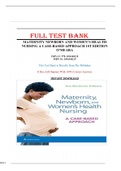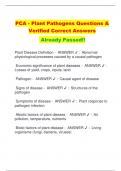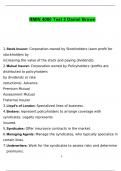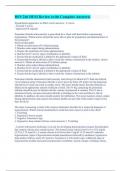Med C
, Maternity Newborn and Women’s Health Nursing A Case-Based Approach 1st Edition
O’Meara Test Bank
Chapter 1 Immediate Postpartum Hemorrhage
MULTIPLE CHOICE
1. A pregnant woman is being discharged from the hospital after the placement of a cervical
cerclage because of a history of recurrent pregnancy loss, secondary to an incompetent cervix.
Which information regarding postprocedural care should the nurse emphasize in the discharge
teaching?
a. Any vaginal discharge should be immediately reported to her health care provider.
b. The presence of any contractions, rupture of membranes (ROM), or severe perineal pressure sho
c. The client will need to make arrangements for care at home, because her activity level will be res
d. The client will be scheduled for a cesarean birth.
ANS: B
Nursing care should stress the importance of monitoring for the signs and symptoms of preterm
labor. Vaginal bleeding needs to be reported to her primary health care provider. Bed rest is an
element of care. However, the woman may stand for periods of up to 90 minutes, which allows
her the freedom to see her physician. Home uterine activity monitoring may be used to limit the
womans need for visits and to monitor her status safely at home. The cerclage can be removed at
37 weeks of gestation (to prepare for a vaginal birth), or a cesarean birth can be planned.
DIF: Cognitive Level: Apply REF: dm. 675
TOP: Nursing Process: Planning | Nursing Process: Implementation
MSC: Client Needs: Health Promotion and Maintenance
2. A perinatal nurse is giving discharge instructions to a woman, status postsuction, and curettage
secondary to a hydatidiform mole. The woman asks why she must take oral contraceptives for
the next 12 months. What is the bestresponse by the nurse?
If you get pregnant within 1 year, the chance of a successful pregnancy is very small. Therefore,
a. pregnancy, it would be better for you to use the most reliable method of contraception available.
The major risk to you after a molar pregnancy is a type of cancer that can be diagnosed only by m
hormone that your body produces during pregnancy. If you were to get pregnant, then it would m
b. this cancer more difficult.
If you can avoid a pregnancy for the next year, the chance of developing a second molar pregnan
c. improve your chance of a successful pregnancy, not getting pregnant at this time is best.
d. Oral contraceptives are the only form of birth control that will prevent a recurrence of a molar pr
ANS: B
Betahuman chorionic gonadotropin (beta-hCG) hormone levels are drawn for 1 year to ensure
that the mole is completely gone. The chance of developing choriocarcinoma after the
development of a hydatidiform mole is increased. Therefore, the goal is to achieve a zero human
chorionic gonadotropin (hCG) level. If the woman were to become pregnant, then it may obscure
the presence of the potentially carcinogenic cells. Women should be instructed to use birth
control for 1 year after treatment for a hydatidiform mole. The rationale for avoiding pregnancy
Med C
,for 1 year is to ensure that carcinogenic cells are not present. Any contraceptive method except
an intrauterine device (IUD) is acceptable.
DIF: Cognitive Level: Apply REF: dm. 679
TOP: Nursing Process: Planning | Nursing Process: Implementation
MSC: Client Needs: Physiologic Integrity
3. The nurse is preparing to administer methotrexate to the client. This hazardous drug
is most often used for which obstetric complication?
a. Complete hydatidiform mole
b. Missed abortion
c. Unruptured ectopic pregnancy
d. Abruptio placentae
ANS: C
Methotrexate is an effective nonsurgical treatment option for a hemodynamically stable woman
whose ectopic pregnancy is unruptured and measures less than 4 cm in diameter. Methotrexate is
not indicated or recommended as a treatment option for a complete hydatidiform mole, for a
missed abortion, or for abruptio placentae.
DIF: Cognitive Level: Apply REF: dm. 677 TOP: Nursing Process: Planning
MSC: Client Needs: Physiologic Integrity
4. A 26-year-old pregnant woman, gravida 2, para 1-0-0-1, is 28 weeks pregnant when she
experiences bright red, painless vaginal bleeding. On her arrival at the hospital, which diagnostic
procedure will the client most likely have performed?
a. Amniocentesis for fetal lung maturity
b. Transvaginal ultrasound for placental location
c. Contraction stress test (CST)
d. Internal fetal monitoring
ANS: B
The presence of painless bleeding should always alert the health care team to the possibility of
placenta previa, which can be confirmed through ultrasonography. Amniocentesis is not
performed on a woman who is experiencing bleeding. In the event of an imminent delivery, the
fetus is presumed to have immature lungs at this gestational age, and the mother is given
corticosteroids to aid in fetal lung maturity. A CST is not performed at a preterm gestational age.
Furthermore, bleeding is a contraindication to a CST. Internal fetal monitoring is also
contraindicated in the presence of bleeding.
DIF: Cognitive Level: Apply REF: dm. 680
TOP: Nursing Process: Assessment MSC: Client Needs: Health Promotion and Maintenance
5. A laboring woman with no known risk factors suddenly experiences spontaneous ROM. The
fluid consists of bright red blood. Her contractions are consistent with her current stage of labor.
No change in uterine resting tone has occurred. The fetal heart rate (FHR) begins to decline
rapidly after the ROM. The nurse should suspect the possibility of what condition?
a. Placenta previa
b. Vasa previa
c. Severe abruptio placentae
Med C
, d. Disseminated intravascular coagulation (DIC)
ANS: B
Vasa previa is the result of a velamentous insertion of the umbilical cord. The umbilical vessels
are not surrounded by Wharton jelly and have no supportive tissue. The umbilical blood vessels
thus are at risk for laceration at any time, but laceration occurs most frequently during ROM. The
sudden appearance of bright red blood at the time of ROM and a sudden change in the FHR
without other known risk factors should immediately alert the nurse to the possibility of vasa
previa. The presence of placenta previa most likely would be ascertained before labor and is
considered a risk factor for this pregnancy. In addition, if the woman had a placenta previa, it is
unlikely that she would be allowed to pursue labor and a vaginal birth. With the presence of
severe abruptio placentae, the uterine tonicity typically is tetanus (i.e., a boardlike uterus). DIC is
a pathologic form of diffuse clotting that consumes large amounts of clotting factors, causing
widespread external bleeding, internal bleeding, or both. DIC is always a secondary diagnosis,
often associated with obstetric risk factors such as the hemolysis, elevated liver enzyme levels,
and low platelet levels (HELLP) syndrome. This woman did not have any prior risk factors.
DIF: Cognitive Level: Analyze REF: dm. 684 TOP: Nursing Process: Diagnosis
MSC: Client Needs: Physiologic Integrity
6. A woman arrives for evaluation of signs and symptoms that include a missed period, adnexal
fullness, tenderness, and dark red vaginal bleeding. On examination, the nurse notices an
ecchymotic blueness around the womans umbilicus. What does this finding indicate?
a. Normal integumentary changes associated with pregnancy
b. Turner sign associated with appendicitis
c. Cullen sign associated with a ruptured ectopic pregnancy
d. Chadwick sign associated with early pregnancy
ANS: C
Cullen sign, the blue ecchymosis observed in the umbilical area, indicates hematoperitoneum
associated with an undiagnosed ruptured intraabdominal ectopic pregnancy. Linea nigra on the
abdomen is the normal integumentary change associated with pregnancy and exhibits a brown
pigmented, vertical line on the lower abdomen. Turner sign is ecchymosis in the flank area, often
associated with pancreatitis. A Chadwick sign is a blue-purple cervix that may be seen during or
around the eighth week of pregnancy.
DIF: Cognitive Level: Analyze REF: dm. 676
TOP: Nursing Process: Assessment MSC: Client Needs: Physiologic Integrity
7. The nurse who elects to practice in the area of womens health must have a thorough
understanding of miscarriage. Which statement regarding this condition is most accurate?
a. A miscarriage is a natural pregnancy loss before labor begins.
b. It occurs in fewer than 5% of all clinically recognized pregnancies.
c. Careless maternal behavior, such as poor nutrition or excessive exercise, can be a factor in causi
If a miscarriage occurs before the 12th week of pregnancy, then it may be observed only as mode
d. blood loss.
ANS: D
Before the sixth week, the only evidence might be a heavy menstrual flow. After the 12th week,
more severe pain, similar to that of labor, is likely. Miscarriage is a natural pregnancy loss, but it
Med C







